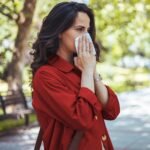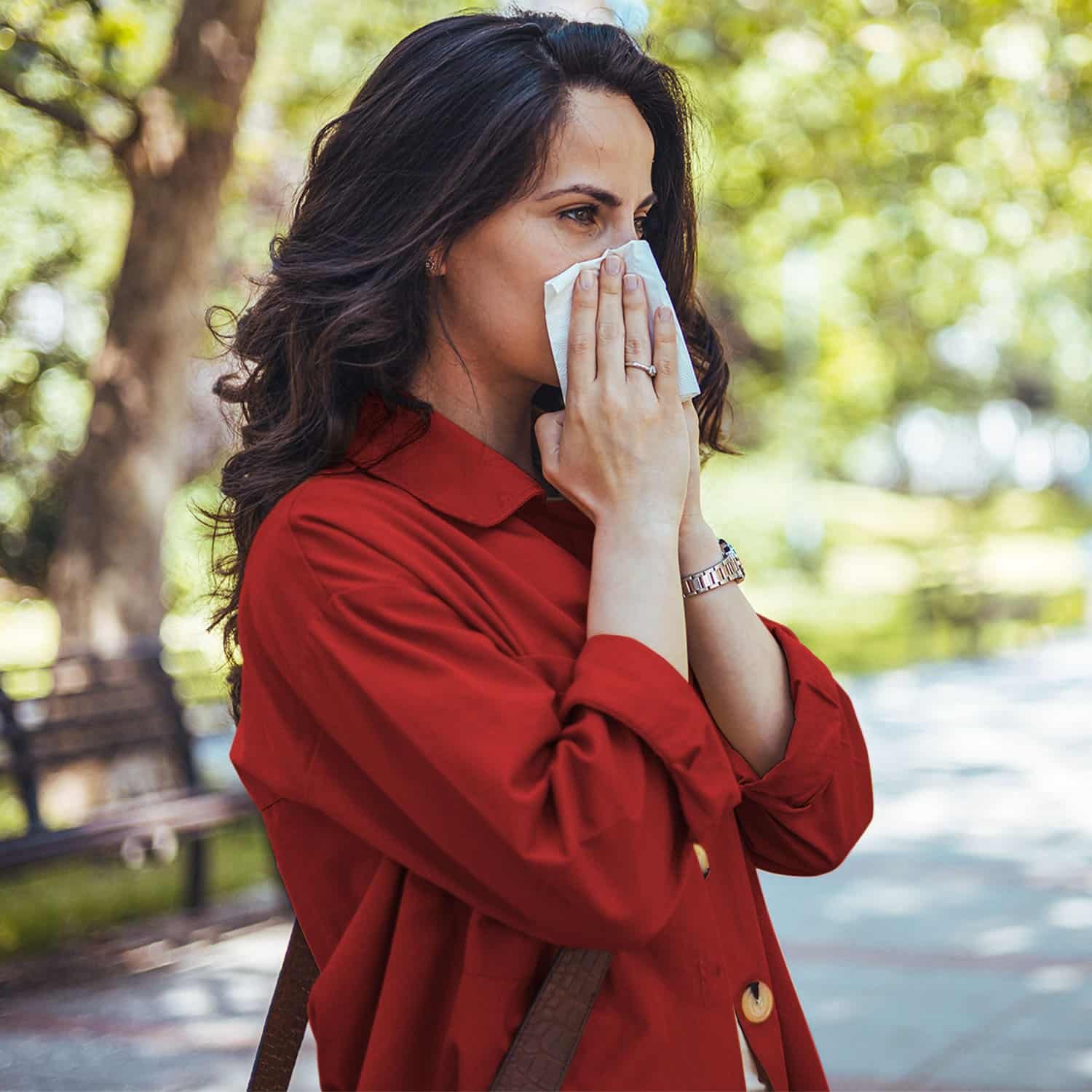There are certain times of the year when seasonal allergy symptoms such as nasal congestion, sneezing, or watery eyes proliferate. Also known as allergic rhinitis, this condition doesn’t affect everyone equally. What are seasonal allergies? Discover the causes and most effective remedies.
What are seasonal allergies?
Seasonal allergies occur during certain times of the year. They are most common in spring and summer, although some people also suffer from them in the fall. They are sometimes referred to as hay fever, a term that can be confusing because fever is not one of their common symptoms.
It’s a reaction of the immune system to contact with certain particles suspended in the air, usually pollen or grass. This connection with nature is precisely what causes its symptoms to manifest seasonally.
So much so that seasonal allergies can appear at different times of the year depending on the climate and location of each region.
Common symptoms of seasonal allergies
It’s important to note that seasonal allergy symptoms affect individuals asymmetrically. Furthermore, the causative agent may trigger some symptoms more than others.
Seasonal rhinitis in winter
We call seasonal rhinitis in winter the characteristic allergy of this time of year. In Spain, pollen levels are low during the cold months, but symptoms associated with dust, Christmas trees, or pets may appear.
People who suffer from seasonal rhinitis experience their symptoms in poorly ventilated indoor spaces. The most common symptoms are nasal congestion, sneezing, and watery eyes.
Seasonal allergy symptoms in spring
Spring is the time of year with the highest incidence of seasonal allergies. Pollen levels in the air are very high. Furthermore, frequent gusts of wind make these agents more likely to spread.
Among the main symptoms of seasonal allergies in spring are a runny nose , sneezing , congestion , and itching . All of these tend to concentrate on the membrane that lines the nasal cavity. Watery eyes may also occur when spores infect the eyes.
Seasonal allergy symptoms in autumn
Ragweed and dust mites are often the main causes of seasonal fall allergies. The main symptoms at this time of year are an itchy nose, watery eyes, a runny nose, and sneezing.
Specific manifestations of seasonal allergies
Seasonal allergies can also cause specific symptoms. Here are some of them.
Seasonal eye allergies
When agents that react with the immune system affect the membrane that covers the eyelids and the white part of the eyes, pathologies such as allergic conjunctivitis may appear.
Those who suffer from it experience itchy , red eyes . Another common symptom of seasonal allergies is watery eyes .
Seasonal throat allergies
Seasonal allergy symptoms affecting the throat include tingling or irritation in the area. Occasionally, the palate can also be affected. Sufferers often experience itchy throats and coughing fits .
Impact on quality of life and sleep
It’s important to note that seasonal allergies don’t just trigger physical reactions. They have a significant impact on the quality of life of those who suffer from them. Fatigue and lack of energy are common consequences that affect the performance of those who suffer from them.
Another consequence we tend to overlook, and it’s not minor, is its impact on sleep quality. Sneezing, congestion, and itching make it difficult to fall asleep. Addressing its symptoms appropriately is key to minimizing the negative effects and thus contributing to a healthy lifestyle.
Causes and triggers of seasonal allergies
As we mentioned, nature’s reproductive cycles and our seasonal habits make us more exposed to certain allergens. These are the main triggers:
| Season | Causes of seasonal allergies | Characteristics |
| Spring | Tree pollen. | Such as pine, blueberry, oats, rye, or Bermuda grass. |
| Mold. | Fungi on rotten trunks and leaves that release spores. | |
| Weed pollen. | In spring, grasses and weeds sprout on the ground. | |
| Summer | Grass pollen. | Very characteristic of swimming pools and gardens. |
| Tree pollen. | For example, nettle. | |
| Autumn | Ragweed pollen. | Species that grow in spring areas and pollinate in September and October. |
| Dust. | Accumulated, for example, in unused heating systems. | |
| Winter | Pets. | They produce allergies through contact with the dandruff in their fur. |
| Mites. | They proliferate in carpets, blankets, and sofas. |
What causes seasonal allergic rhinitis?
Common signs of seasonal allergic rhinitis include sneezing and a runny nose. However, more severe cases can cause headaches and earaches due to poor sinus drainage. Some people may even develop bronchial asthma.
How to prevent seasonal allergy symptoms
Do you suffer from seasonal allergies? Here are some tips to prevent their symptoms.
Reducing exposure to allergens
Avoiding contact with allergens is essential. Specifically, it is recommended to limit outdoor activities between 5 and 10 a.m., the peak pollen emission period. Likewise, limit your outdoor activities between 7 and 10 p.m., when pollen descends from the atmosphere as the air cools.
If you travel by car, it is advisable to keep the windows closed and turn on the vehicle’s ventilation system.
Remember not to hang clothes on terraces, balconies, or in gardens, as pollination debris easily adheres to the fabrics.
Changes in the home and daily habits
Vacuum carpets, sofas, cushions, and sheets regularly to trap any allergens. Another effective home tip is to install an air purifier with a good HEPA filter capable of trapping tiny allergy-causing particles.
Keep your windows closed at night and try to stay indoors as much as possible. And remember to practice good daily hygiene. Shower every time you return from outside and wash your hands frequently.
Seasonal Allergy Treatments and Remedies
Several medications help reduce the symptoms of seasonal allergic rhinitis. However, remember to always do so under the supervision of a specialist:
- Antihistamines. These help block or reduce allergy symptoms.
- Decongestants. Solutions are available in liquid or spray form to relieve nasal pressure.
- Nasal corticosteroids . They reduce inflammation of the nasal passages.
- Immunotherapies . There is an injection treatment for people with more severe allergies. They require medical supervision and aim to develop a degree of natural immunity.
Frequently Asked Questions
How do I know if I have seasonal allergies?
There are medical tests that can diagnose allergies through skin tests . They can also be detected by comparing contact with pollen with common seasonal allergy symptoms.
How to relieve seasonal allergy symptoms?
Treatments based on antihistamines or decongestant solutions are effective in relieving symptoms.
What are the symptoms of seasonal allergies in winter?
Sneezing , runny nose , irritation of the throat, eyes and nasal passages, as well as watery eyes are the most common symptoms.
What remedies are most effective for seasonal rhinitis in winter?
Installing an air purifier helps eliminate germs, mites, and pollen from the environment. It’s also recommended to vacuum carpets, sofas, and fabrics frequently.
How do seasonal allergies affect the eyes and throat?
Irritation and itching in the throat and eyes are common consequences of allergies.





















+ There are no comments
Add yours